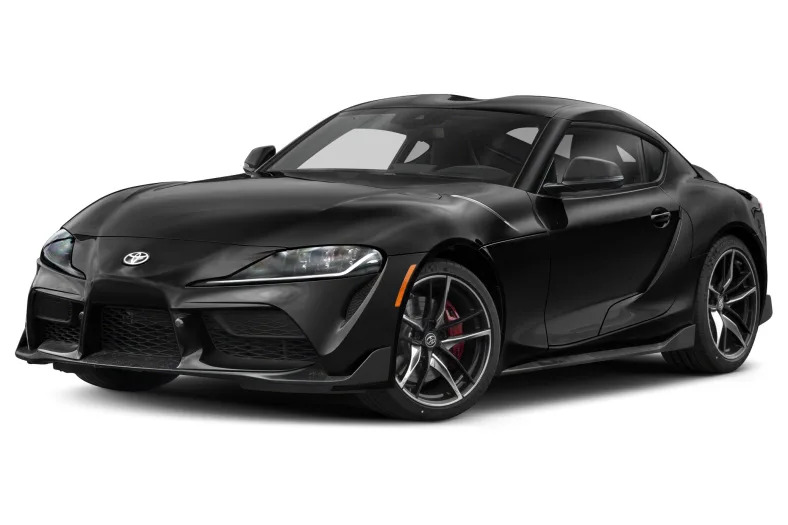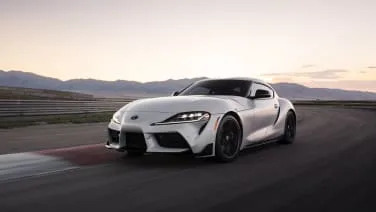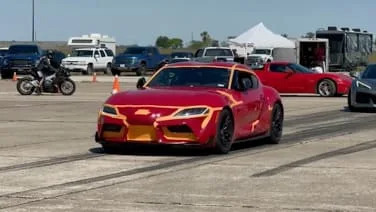3.0 Premium 3dr Coupe
2021 Toyota Supra
It seems virtually every new car is offered with a 2.0-liter turbocharged four-cylinder engine these days. Including, starting with the 2021 model year, the base version of the Toyota Supra. It’s impressive how much power and efficiency automakers have wrung out of a soda bottle’s worth of displacement, but not all of these small-but-mighty powerplants fulfill their missions with the same level of success. Including, again, the base version of the Toyota Supra. By now, you’re probably aware that the reborn Supra relies heavily on parts and engineering sourced from BMW. In many ways, this is not a bad thing — BMW clearly knows how to screw together a solid automobile. The Supra shares most of its oily bits with the BMW Z4, including its inline-four- and six-cylinder engines and eight-speed automatic transmissions (a manual is coming only for the inline-six for 2023). This version of the ubiquitous 2.0-liter turbo produces 255 horsepower and 295 pound-feet of torque, which is plenty to provide accelerative entertainment in a small car like the Supra. Toyota claims it’ll do 0-60 in about 5 seconds. But there’s more to the experience of a small, lithe, two-seat sports car than properly quick acceleration. And unfortunately, this is where the 2.0-liter falls a bit flat. Opinions vary on how much it matters, but the engine’s power delivery doesn’t feel appropriate for a vehicle with the sporting intentions of the Supra. There’s solid grunt just a few hundred revs past the engine’s idle, and the power continues pretty much seamlessly throughout the middle of the four-cylinder’s rev range — not surprising, considering Toyota and BMW say it makes peak torque between 1,550 and 4,400 rpm. But there’s no exhilarating rush as it winds toward its shift point around 7,000 rpm, no great audible excitement in its soundtrack … and no clutch pedal to make it feel more involving that it otherwise may be. To be clear, none of our qualms with the turbocharged four-cylinder make the Supra a bad car. It’s not. In fact, it’s a rather good one. But, as we wrote after our initial few hours driving the new-for-2021 Supra 2.0, “it’s acceptable and still plenty good to drive, but it’s no Supra miracle.” Put simply, for the full-fat, soul-stirring Supra experience, the inline-six with its 382 hp and 368 lb-ft is a more moving and ultimately more desirable option. Our quibbles with the base Supra extend beyond its powerplant. One noteworthy subtraction is the 3.0’s adaptive suspension, removed in favor of standard fixed springs and dampers. So, whereas a Supra 3.0 owner can choose from three distinct modes that move from firm-but-compliant to boom-crash, Supra 2.0 owners get something in between. We found the ride to be pretty good on relatively smooth asphalt, but throw a frost heave or pothole into the mix and things go south quickly. Long stints behind the wheel on iffy pavement left us wishing we could soften things up for a more grand-touring experience, something that’s possible with the …
Full Review
It seems virtually every new car is offered with a 2.0-liter turbocharged four-cylinder engine these days. Including, starting with the 2021 model year, the base version of the Toyota Supra. It’s impressive how much power and efficiency automakers have wrung out of a soda bottle’s worth of displacement, but not all of these small-but-mighty powerplants fulfill their missions with the same level of success. Including, again, the base version of the Toyota Supra. By now, you’re probably aware that the reborn Supra relies heavily on parts and engineering sourced from BMW. In many ways, this is not a bad thing — BMW clearly knows how to screw together a solid automobile. The Supra shares most of its oily bits with the BMW Z4, including its inline-four- and six-cylinder engines and eight-speed automatic transmissions (a manual is coming only for the inline-six for 2023). This version of the ubiquitous 2.0-liter turbo produces 255 horsepower and 295 pound-feet of torque, which is plenty to provide accelerative entertainment in a small car like the Supra. Toyota claims it’ll do 0-60 in about 5 seconds. But there’s more to the experience of a small, lithe, two-seat sports car than properly quick acceleration. And unfortunately, this is where the 2.0-liter falls a bit flat. Opinions vary on how much it matters, but the engine’s power delivery doesn’t feel appropriate for a vehicle with the sporting intentions of the Supra. There’s solid grunt just a few hundred revs past the engine’s idle, and the power continues pretty much seamlessly throughout the middle of the four-cylinder’s rev range — not surprising, considering Toyota and BMW say it makes peak torque between 1,550 and 4,400 rpm. But there’s no exhilarating rush as it winds toward its shift point around 7,000 rpm, no great audible excitement in its soundtrack … and no clutch pedal to make it feel more involving that it otherwise may be. To be clear, none of our qualms with the turbocharged four-cylinder make the Supra a bad car. It’s not. In fact, it’s a rather good one. But, as we wrote after our initial few hours driving the new-for-2021 Supra 2.0, “it’s acceptable and still plenty good to drive, but it’s no Supra miracle.” Put simply, for the full-fat, soul-stirring Supra experience, the inline-six with its 382 hp and 368 lb-ft is a more moving and ultimately more desirable option. Our quibbles with the base Supra extend beyond its powerplant. One noteworthy subtraction is the 3.0’s adaptive suspension, removed in favor of standard fixed springs and dampers. So, whereas a Supra 3.0 owner can choose from three distinct modes that move from firm-but-compliant to boom-crash, Supra 2.0 owners get something in between. We found the ride to be pretty good on relatively smooth asphalt, but throw a frost heave or pothole into the mix and things go south quickly. Long stints behind the wheel on iffy pavement left us wishing we could soften things up for a more grand-touring experience, something that’s possible with the …
Hide Full Review
Hide Full Review
Retail Price
$54,590
MSRP / Window Sticker Price
| Engine | 3.0L I-6 |
| MPG | 22 City / 30 Hwy |
| Seating | 2 Passengers |
| Transmission | 8-spd auto w/OD |
| Power | 382 @ 5800 rpm |
| Drivetrain | rear-wheel |
Smart Buy Program is powered by 






